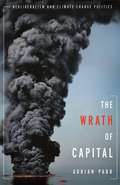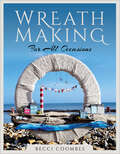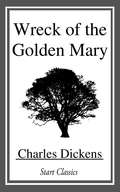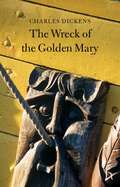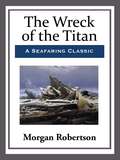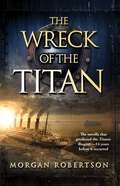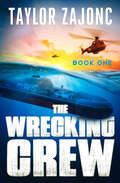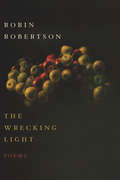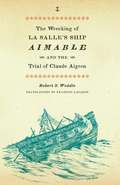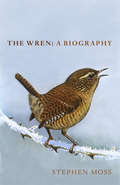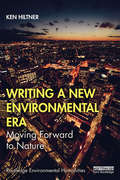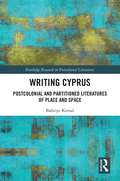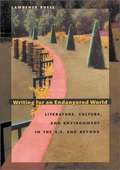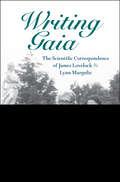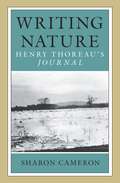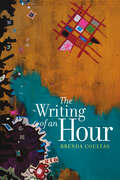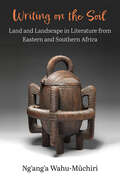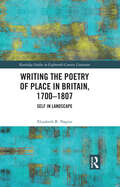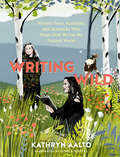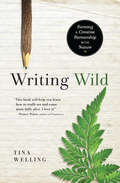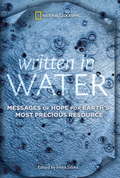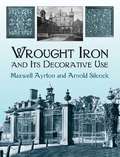- Table View
- List View
The Wrath of Capital: Neoliberalism and Climate Change Politics (New Directions in Critical Theory #48)
by Adrian ParrAlthough climate change has become the dominant concern of the twenty-first century, global powers refuse to implement the changes necessary to reverse these trends. Instead, they have neoliberalized nature and climate change politics and discourse, and there are indications of a more virulent strain of capital accumulation on the horizon. Adrian Parr calls attention to the problematic socioeconomic conditions of neoliberal capitalism underpinning the world's environmental challenges, and she argues that, until we grasp the implications of neoliberalism's interference in climate change talks and policy, humanity is on track to an irreversible crisis.Parr not only exposes the global failure to produce equitable political options for environmental regulation, but she also breaks down the dominant political paradigms hindering the discovery of viable alternatives. She highlights the neoliberalization of nature in the development of green technologies, land use, dietary habits, reproductive practices, consumption patterns, design strategies, and media. She dismisses the notion that the free market can solve debilitating environmental degradation and climate change as nothing more than a political ghost emptied of its collective aspirations. Decrying what she perceives as a failure of the human imagination and an impoverishment of political institutions, Parr ruminates on the nature of change and existence in the absence of a future. The sustainability movement, she contends, must engage more aggressively with the logic and cultural manifestations of consumer economics to take hold of a more transformative politics. If the economically powerful continue to monopolize the meaning of environmental change, she warns, new and more promising collective solutions will fail to take root.
Wreath Making for all Occasions (Make Your Own Ser.)
by Becci CoombesEven a quick walk in the countryside or Sunday stroll along the beach can yield the most interesting and attractive materials for making beautiful decorations for the home. In this book Becci will show you how to form simple wreaths out of foraged elements, with an emphasis on recycling and using sustainable materials. Basic techniques for a variety of seasonal projects are demonstrated, and these can then be used to create smaller garlands, such as napkin rings and candle table centres. Becci focuses on commonly found elements, foraging for plants and foliage and sourcing inspiration from nature; you don’t need to be a trained florist to design gorgeous wreaths and garlands for yourself or your friends. The featured projects will cover wreaths for all seasons, from scented lavender hearts to harvest festival straw circles, and we will explore how to make them from more unusual materials such as pool noodles. The emphasis will be on recycling too, so you will be able to create a garland that can be changed throughout the year to suit your decor and mood.
Wreck of the Golden Mary
by Charles DickensThe Wreck of the Golden Mary is the work of many hands but was originally started by Dickens. The story portrays an amazing voyage around Cape Horn, then north to the coast of California. It takes a stunning turn when the ship strikes an iceberg and passengers and crew languish in lifeboats. Dickens's subtlety of style and picturesque depiction keeps reader rapt till the end.
The Wreck of the Golden Mary (Hesperus Classics)
by Charles DickensIngeniously conceived and brilliantly rendered, and set against the backdrop of the California Gold Rush, The Wreck of the Golden Mary is a masterpiece of Victorian storytelling. En route to making their fortunes, the passengers of the Golden Mary suffer a terrifying ordeal when their vessel collides with an iceberg. Now the helpless victims of a shipwreck, they turn to the restorative powers of storytelling in a desperate attempt to raise morale. As each takes their turn, from the captain to the first mate, the Dickensian figures of miser and murderer, orphan and ghost, are brought onboard with most remarkable effect. Charles Dickens is one of England' s most important literary figures. His works enjoyed enormous success in his day and are still among the most popular classics of all time.
The Wreck of the Titan
by Morgan RobertsonThe Wreck of the Titan was written fourteen years before the sinking of the Titanic. The events in book are eerily similar to the actual events that would not happen for more than a decade. Titan the largest ship in the line is considered to be unsinkable, it is roughly the same size as the Titanic with about the same number of passengers, it was not provided with enough life boats for all of its passages, and half of the passengers died when it sank after hitting an iceberg in the Atlantic Ocean. So similar were the incidents described in the book to the sinking of the Titanic that many people credited the author, Morgan Robertson, with clairvoyance. The Dr. Who episode of the same name was based on the events in this book. A story of tragedy, loss, love and redemption.
The Wreck of the Titan
by Morgan RobertsonA novella of unrequited love, human arrogance, and deadly tragedy that predicted the legendary Titanic disaster...fourteen years before it happened. In 1898, Morgan Robertson penned The Wreck of the Titan, a love story set aboard the Titan, the most advanced steamship of the age. When the "unsinkable" passenger liner hit an iceberg, nearly all its passengers perished at sea. On April 15, 1912, the most advanced steamship of its age, the "unsinkable" Titanic, struck an iceberg and was lost to the ocean, becoming forever immortalized as a cultural touchstone. The similarities between the fact of the Titanic and the fiction of the Titan are more than just name-deep. Both stories tell the tale of real humans faced with an unfathomable disaster, and the hopes of humankind at the turn of a new century. As the 100th anniversary of the sinking of the Titanic is remembered, Robertson's work of fiction gives great insights into the human scope of the tragedy...and the enduring power of love. Includes a special excerpt from the all-new Titanic thriller, The Titanic Secret, by Jack Steel--Available in stores and online now!
The Wrecking Crew (The Wrecking Crew Novels)
by Taylor Zajonc&“Fans of action-packed thrillers with nautical settings will be more than satisfied with Zajonc&’s accomplished debut, which kicks off a promising series&” —Publishers Weekly, starred review). The pirate-plagued waters of Somalia have gotten even more deadly since a mysterious red tide began killing all marine life within its reach. When a research team attempting to study the phenomenon is shot out of the sky, extraordinary measures are required to investigate. In exchange for his freedom from a secret Moroccan prison, salvage diver Jonah Blackwell agrees to lead a covert search for the missing scientists. But when his expedition threatens the ambitions of billionaire industrialist Charles Bettencourt, Jonah must assemble an untested crew to discover the source of a terrifying plague while facing down Bettencourt&’s private army.
The Wrecking Light: Poems
by Robin RobertsonShortlisted for the T.S. Eliot Prize, the Scottish poet’s fourth collection shimmers with “an oneiric charge and intensity” (Guardian, UK).The Wrecking Light is an intense, moving, bleakly lyrical, and at times shocking book. These poems are written with the authority of classical myth, yet sound utterly contemporary. The poet’s gaze—whether on the natural world or the details of his own life—is unflinching and clear, its utter seriousness leavened by a wry, dry, and disarming humor.Alongside fine translations from Neruda and Montale and dynamic retellings of stories from Ovid, the poems here pitch the power and wonder of nature against the frailty and failure of human beings. This is a book of considerable grandeur and sweep that confirms Robertson as one of the most arresting and powerful poets at work today.
The Wrecking of La Salle's Ship Aimable and the Trial of Claude Aigron
by Robert S. WeddleWhen Robert Cavelier, sieur de La Salle, landed on the Texas coast in 1685, bent on founding a French colony, his enterprise was doomed to failure. Not only was he hundreds of miles from his intended landfall--the mouth of the Mississippi--but his supply ship, Aimable, was wrecked at the mouth of Matagorda Bay, leaving the colonists with scant provisions and little protection against local Indian tribes. In anger and disgust, he struck out at the ship's captain, Claude Aigron, accusing him of wrecking the vessel purposely and maliciously. Captain Aigron and his crew escaped the doomed colony by returning to France on the warship that had escorted the expedition on its ocean crossing. Soon after reaching France, Aigron found himself defendant in a civil suit filed by two of his officers seeking recompense for lost salary and personal effects, and then imprisoned on order of King Louis XIV while La Salle's more serious accusations were being investigated. In this book, Robert Weddle meticulously recounts, through court documents, the known history of Aigron and the Aimable, and finds that despite La Salle's fervent accusations, the facts of the case offer no clear indictment. The court documents, deftly translated by François Lagarde, reveal Captain Aigron's successful defense and illuminate the circumstances of the wreck with Aigron's testimony. Much is also revealed about the French legal system and how the sea laws of the period were applied through the French government's L'Ordonnance de la Marine.
The Wren: A Biography (The Bird Biography Series #2)
by Stephen MossFrom the bestselling author of The Robin: A Biography, Stephan Moss:The wren is a paradox of a bird. They are Britain's most common bird, with 8.5 million breeding pairs and have by far the loudest song in proportion to their size. They also thrive up and down Britain and Ireland: from the smallest city garden to remote offshore islands, blustery moors to chilly mountains. Yet many people are not sure if they have ever seen a wren. Perhaps because the wren is so tiny, weighing just as much as two A4 sheets of paper, and so busy, always on the move, more mouse than bird.However if we cast our eyes back to recent history wrens were a mainstay of literary, cultural and popular history. The wren was on postage stamps and the farthing, it featured in nursery rhymes and greetings cards, poems and rural 'wren hunts', still a recent memory in Ireland particularly.With beautiful illustrations throughout, this captivating year-in-the-life biography reveals the hidden secrets of this fascinating bird that lives right on our doorstep.
Writing a New Environmental Era: Moving forward to nature (Routledge Environmental Humanities)
by Ken HiltnerWriting a New Environmental Era first considers and then rejects back-to-nature thinking and its proponents like Henry David Thoreau, arguing that human beings have never lived at peace with nature. Consequently, we need to stop thinking about going back to what never was and instead work at moving forward to forge a more harmonious relationship with nature in the future. Using the rise of the automobile and climate change denial literature to explore how our current environmental era was written into existence, Ken Hiltner argues that the humanities—and not, as might be expected, the sciences—need to lead us there. In one sense, climate change is caused by a rise in atmospheric CO2 and other so-called greenhouse gases. Science can address this cause. However, approached in another way altogether, climate change is caused by a range of troubling human activities that require the release of these gases, such as our obsessions with cars, lavish houses, air travel and endless consumer goods. The natural sciences may be able to tell us how these activities are changing our climate, but not why we are engaging in them. That’s a job for the humanities and social sciences. As this book argues, we need to see anthropogenic (i.e. human-caused) climate change for what it is and address it as such: a human problem brought about by human actions. A passionate and personal exploration of why the Environmental Humanities matter and why we should be looking forward, not back to nature, this book will be essential reading for all those interested in the future and sustainability of our planet.
Writing Cyprus: Postcolonial and Partitioned Literatures of Place and Space (Routledge Research in Postcolonial Literatures)
by Bahriye KemalBahriye Kemal's ground-breaking new work serves as the first study of the literatures of Cyprus from a postcolonial and partition perspective. Her book explores Anglophone, Hellenophone and Turkophone writings from the 1920s to the present. Drawing on Yi-Fu Tuan’s humanistic geography and Henri Lefebvre’s Marxist philosophy, Kemal proposes a new interdisciplinary spatial model, at once theoretical and empirical, that shows the power of space and place in postcolonial partition cases. The book shows the ways that place and space determine identity so it is understood as identification, together these places, spaces and identifications are always in production. In analysing practices towards writing, inventing, experiencing, reading and construction, the book offers a distinct ‘solidarity’ that captures the ‘truth of space’ and place for the production of multiple-mutable Cypruses shaped by and for multiple-mutable selves, ending in a 'differential’ Cyprus, Mediterranean, and world. Writing Cyprus presents not only a nuanced understanding of the actual and active production of colonialism, postcolonialism and partition that dismantles the dominant binary legacy of historical-political deadlock discourse, but a fruitful model for understanding other sites of conflict and division.
Writing For an Endangered World: Literature, Culture, and Environment in the U. S. and Beyond
by Lawrence BuellThe environmental imagination does not stop short at the edge of the woods. Nor should our understanding of it, as Lawrence Buell makes clear in this book that aims to reshape the field of literature and environmental studies. Emphasizing the influence of the physical environment on individual and collective perception, his book thus provides the theoretical underpinnings for ecocriticism.
Writing Gaia: The Scientific Correspondence of James Lovelock and Lynn Margulis
by Bruce Clarke Sébastien DutreuilIn 1972, James Lovelock and Lynn Margulis began collaborating on the Gaia hypothesis. They suggested that over geological time, life on Earth has had a major role in both producing and regulating its own environment. Gaia is now an ecological and environmental worldview underpinning vital scientific and cultural debates over environmental issues. Their ideas have transformed the Earth and life sciences, as well as contemporary conceptions of nature. Their correspondence describes these crucial developments from the inside, showing how their partnership proved decisive for the development of the Gaia hypothesis. Clarke and Dutreuil provide historical background and explain the concepts and references introduced throughout the Lovelock-Margulis correspondence, while highlighting the major landmarks of their collaboration within the sequence of almost 300 letters written between 1970 and 2007. This book will be of interest to researchers in ecology, history of science, environmental history and climate change, and cultural science studies.
Writing Metamorphosis in the English Renaissance
by Susan WisemanTaking Ovid's Metamorphoses as its starting point, this book analyses fantastic creatures including werewolves, bear-children and dragons in English literature from the Reformation to the late seventeenth century. Susan Wiseman tracks the idea of transformation through classical, literary, sacred, physiological, folkloric and ethnographic texts. Under modern disciplinary protocols these areas of writing are kept apart, but this study shows that in the Renaissance they were woven together by shared resources, frames of knowledge and readers. Drawing on a rich collection of critical and historical studies and key philosophical texts including Descartes' Meditations, Wiseman outlines the importance of metamorphosis as a significant literary mode. Her examples range from canonical literature, including Shakespeare's A Midsummer Night's Dream and The Tempest, to Thomas Browne on dragons, together with popular material, arguing that the seventeenth century is marked by concentration on the potential of the human, and the world, to change or be changed.
Writing Nature: Henry Thoreau's Journal
by Sharon CameronAt his death, Henry Thoreau left the majority of his writing unpublished. The bulk of this material is a journal that he kept for twenty-four years. Sharon Cameron's major claim is that this private work (the Journal) was Thoreau's primary work, taking precedence over the books that he published in his lifetime. Her controversial thesis views Thoreau's Journal as a composition that confounds the distinction between public and private--the basis on which our conventional treatment of discourse depends.
The Writing of an Hour (Wesleyan Poetry Series)
by Brenda CoultasWhat actually happens within the revolution of the clock's hands? In The Writing of an Hour the poet considers the effort and the deliberateness that brings her to her desk each day. Despite domestic and day job demands and widespread lockdown, Coultas forges connections to the sublime and wonders what it means to be from the Americas. These poems verge on the surreal, transform the quotidian, and respond anew to the marvelous. The Writing of an Hour takes the reader on a journey in four sections; from a bedroom to an improvised desk over the North Sea, where she attempts to create an artwork inside an airplane cabin flying over Greenland's rivers of ice. The Mending HourI tied one on, I mean I took my grandmother's apron, its strings and glittery rickrack and I wore it on the streets of the East Village. The apron is a cloak of superpowers, a psychic umbrella I paraded past Emma Goldman's E. 10th St. address, and rang her doorbell for a sip of water. My domestic armor is made of gingham though a woman is still considered an unelectable candidate.
Writing on the Soil: Land and Landscape in Literature from Eastern and Southern Africa (African Perspectives)
by Ng'ang'a Wahu-MuchiriAcross contiguous nation-states in Eastern Africa, the geographic proximity disguises an ideological complexity. Land has meant something fundamental in the sociocultural history of each country. Those concerns, however, have manifested into varied political events, and the range of struggles over land has spawned a multiplicity of literary interventions. While Kenya and Uganda were both British colonies, Kenya's experience of settler land alienation made for a much more violent response against efforts at political independence. Uganda's relatively calm unyoking from the colonial burden, however, led to a tumultuous post-independence. Tanzania, too, like Kenya and Uganda, resisted British colonial administration—after Germany's defeat in World War 1. In Writing on the Soil, author Ng’ang’a Wahu-Mũchiri argues that representations of land and landscape perform significant metaphorical labor in African literatures, and this argument evolves across several geographical spaces. Each chapter's analysis is grounded in a particular locale: western Kenya, colonial Tanganyika, post-independence Tanzania, Zimbabwe, Nairobi, Dar es Salaam, Anam Ka'alakol (Lake Turkana), Kampala, and Kitgum in Northern Uganda. Moreover, each section contributes to a deeper understanding of the aesthetic choices that authors make when deploying tropes revolving around land, landscape, and the environment. Mũchiri disentangles the numerous connections between geography and geopolitical space on the one hand, and ideology and cultural analysis on the other. This book embodies a multi-layered argument in the sphere of African critical scholarship, while adding to the growing field of African land rights scholarship—an approach that foregrounds the close reading of Africa’s literary canon.
Writing the Poetry of Place in Britain, 1700–1807: Self in Landscape (Routledge Studies in Eighteenth-Century Literature)
by Elizabeth R. NapierThis book discusses the intrusion, often inadvertent, of personal voice into the poetry of landscape in Britain, 1700-1807. It argues that strong conventions, such as those that inhere in topographical verse of the period, invite original poets to overstep those bounds while also shielding them from the repercussions of self-expression. Working under cover of convention in this manner and because for each of these poets place is tied in significant ways to personal history, poets of place may launch unexpected explorations into memory, personhood, and the workings of consciousness. The book supplements traditionally political readings of landscape poetry, turning to questions of self-articulation and self-expression in order to argue that the autobiographical impulse is a distinctive and innovative feature of much great eighteenth-century poetry of place. Among the poets under examination are Pope, Thomson, Duck, Gray, Goldsmith, Crabbe, Cowper, Smith, and Wordsworth.
Writing Wild: Women Poets, Ramblers, and Mavericks Who Shape How We See the Natural World
by Kathryn Aalto&“An exciting, expert, and invaluable group portrait of seminal women writers enriching a genre crucial to our future.&” —Booklist In Writing Wild, Kathryn Aalto celebrates 25 women whose influential writing helps deepen our connection to and understanding of the natural world. These inspiring wordsmiths are scholars, spiritual seekers, conservationists, scientists, novelists, and explorers. They defy easy categorization, yet they all share a bold authenticity that makes their work both distinct and universal. Featured writers include: Dorothy Wordsworth, Susan Fenimore Cooper, Gene Stratton-Porter, Mary Austin, and Vita Sackville-WestNan Shepherd, Rachel Carson, Mary Oliver, Carolyn Merchant, and Annie DillardGretel Ehrlich, Leslie Marmon Silko, Diane Ackerman, Robin Wall Kimmerer, and Lauret SavoyRebecca Solnit, Kathleen Jamie, Carolyn Finney, Helen Macdonald, and Saci LloydAndrea Wulf, Camille T. Dungy, Elena Passarello, Amy Liptrot, and Elizabeth Rush Part travel essay, literary biography, and cultural history, Writing Wild ventures into the landscapes and lives of extraordinary writers and encourages a new generation of women to pick up their pens, head outdoors, and start writing wild.
Writing Wild
by Tina WellingAlign Your Creative Energy with Nature's "Everything we know about creating," writes Tina Welling, "we know intuitively from the natural world." In Writing Wild, Welling details a three-step "Spirit Walk" process for inviting nature to enliven and inspire our creativity.
Written in Water
by Irena SalinaWritten in Water: Messages of Hope for Earth's Most Precious Resource comprises a collection of essays authored by heroes and leaders in the field of water solutions and innovations--a broad range of people from varied disciplines who have contributed their hearts and minds to bringing awareness to and conserving Earth's freshwater supply. In their own words, authors tell of such tragedies as water slavery, drought, or contamination, as well as their own professional struggles and successes in pursuit of freshwater solutions. Contributors include: Alexandra Cousteau, social environmental advocate and granddaughter of legendary marine scientist Jacques Cousteau; Peter Gleick, environmental visionary and winner of a 2003 MacArthur "genius grant"; Bill McKibben, bestselling author and winner of a Guggenheim fellowship; Sylvia Earle, oceanographer and Time magazine's first "hero for the planet"; and Christine Todd Whitman, former head of the Environmental Protection Agency, along with more than a dozen other notable people.These visionaries' stories touch, surprise, and amaze as they help us see the essential role played by water in our world, our lives, and our future. These are all people who are thinking far beyond the realm of self; they are devoted to creating a better world for all of us.
Written in Water
by Irena SalinaWritten in Water is an unforgettable collection of the true stories of people-men and women, politicians and scientists, laymen and experts-sharing in their own words what they have seen and what they have learned in their efforts to bring clean water to all.
Wrought Iron and Its Decorative Use
by Arnold Silcock Maxwell AyrtonA superb treasury of decorative wrought iron, this well-illustrated volume presents an informative survey of the ancient craft's practice throughout England. Its history can be traced simply by admiring the crisp black-and-white illustrations of gates, railings, screens, and other elaborately rendered works. 241 black-and-white illustrations.
WTF, Evolution?!: A Theory of Unintelligible Design
by Mara GrunbaumWe all have our off days. Why should Evolution be any different? Maybe Evolution got carried away with an idea that was just a little too crazy—like having the Regal Horned Lizard defend itself by shooting three-foot streams of blood from its eyes. Or maybe Evolution ran out of steam (Memo to Evolution: The Irrawaddy Dolphin looks like a prototype that should have been left on the drawing board). Or maybe Evolution was feeling cheeky—a fish with hands? Joke’s on you, Red Handfish! Or maybe Evolution simply goofed up: How else to explain the overgrown teeth of the babirusas that curl backward over their face? Oops. Mara Grunbaum is a very smart, very funny science writer who celebrates the best—or, really, the worst—of Evolution’s blunders. Here are more than 100 outlandish mammals, reptiles, insects, fish, birds, and other creatures whose very existence leaves us shaking our heads and muttering WTF?! Ms. Grunbaum’s especially brilliant stroke is to personify Evolution as a well-meaning but somewhat oblivious experimenter whose conversations with a skeptical narrator are hilarious. For almost 4 billion years, Evolution has produced a nonstop parade of inflatable noses, bizarre genitalia, and seriously awkward necks. What a comedian!
